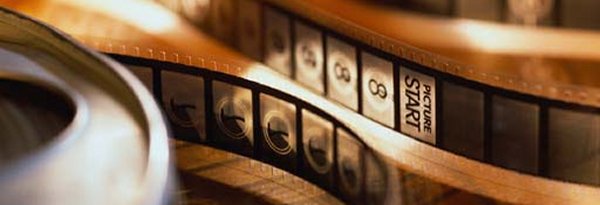Like many cinema buffs, I’ve had very mixed feelings about the rapid decline of 35mm film as both a photographic capture and projection medium for motion pictures. As nostalgic as I may be for the experience of watching a pristine film print properly projected in a good theater, I’ll be the first to admit that, these days, digital projection is usually better, often significantly better, than film projection. Nonetheless, this transition is having the unfortunate side effect of claiming another victim. Can art house and repertory theaters survive without film?
Last year, all of the major manufacturers of motion picture cameras ceased production of new film cameras. More recently, Fuji announced that it would discontinue making film stock, while rival Eastman Kodak fights off bankruptcy. The end of film is fast approaching.
On the one hand, part of me wants to feel indignant about this. When done right, there’s a special luminous quality about light shining through a strip of film that digital projection still can’t quite replicate. Unfortunately, that experience is very rare. I can tell you precisely when I last saw a movie projected on film. Over the summer, I saw the indie comedy ‘Sleepwalk with Me‘ on 35mm. (I didn’t make a special point of seeing it on film; that just happened to be the way it was playing.) Having gotten used to pristine digital presentations, I was taken aback at just how awful the movie looked. The print was flat, washed out, had dull colors, and was positively wrecked with specks and scratches just a week into its run. My nostalgia for film pretty much died that day. While digital projection may be prone to its own share of issues, by and large, it’s far more consistent than film, especially in today’s cinema environment, where multiplexes are staffed exclusively with clueless teenagers who have no idea how to treat a film print or how to work a projector when something goes wrong.
Yet the disappearance of film is taking a serious toll on a valuable institution, the art house and repertory theater market. A recent article in The Atlantic describes how Martin Scorsese had trouble getting a print of his own 1993 movie ‘The Age of Innocence’ for a screening at the Museum of the Moving Image in Queens, because the studio that owns it (Sony) couldn’t find a lab to make a new print for it. Ultimately, Scorsese convinced the studio to supply him an archival print, but how many small theater programmers will have that kind of clout? With studios unable to strike new prints, and increasingly unwilling to loan out older prints for fear of damage, it’s becoming a choice of digital or nothing.
That’s a problem for a couple of reasons. First, many small or rural theaters can’t afford to upgrade to digital yet. Perhaps more importantly, the studios just plain don’t have DCP (Digital Cinema Package) copies of many of their library titles available, especially not for less popular or obscure movies. Even if a repertory theater is equipped for digital projection, it may not be able to get quality copies of the movies it wants to show. As this article in L.A. Weekly explains, many theaters are now forced to project from commercial home video copies on Blu-ray or even DVD, which are far from ideal (especially low-res DVD) on a large theater screen.
Are art house theaters doomed? Is there even still a place for such a thing in the age of home theater, where viewers can watch their favorite old movies on Blu-ray from the comfort of their own couches, without needing to go out to a cinema? I don’t know the answer to this, but I will certainly consider it a damn shame if the only things that ever play at movie theaters are the latest big-budget blockbusters and nothing else.






Chad
Like all businesses, theaters will be forced to evolve. There will be many small, independent theaters that will be sadly forced out of business because they simply can’t afford the quarter of a million dollars it will cost to upgrade to digital projectors.
But so long as there’s an appetite and audience for small films, they will find a way to theaters. Many larger chains, in larger markets, do reserve one or two auditoriums for art house films. So long as you have films like “Moonrise Kingdom” that perform very well, theaters will book those movies (I guess we should stop calling them “films” soon).
Repertory films will be the biggest issue, to be sure. But studios will probably begin converting their catalog to DCP soon for larger titles, and I think most audiences for smaller titles will be perfectly okay watching a Blu-ray copy on the screen. When I go to see revivals, I’m more interested in seeing the movie with an audience than I am a “pristine” print of something. I can get a certain quality at home, but I can’t get that communal experience there.
Ian Whitcombe
I’d see a Blu-ray copy in the theatre, but I seriously doubt it would be that of a movie I already own in my collection. Perhaps if they showed a Criterion/Twilight Time movie, and there’s no rental available or I was on the fence of blind-buying.
Chad
“Casablanca” is a movie I’ve owned on every format available to me, yet I saw it in the theater with an audience and it was a completely different experience.
Ian Whitcombe
Chad, did you see it in the theater projected from a home video format or a theatrical format? I don’t see the point in the former, but I certainly do in the latter.
Chad
It was film, but it was a terrible print. Scratches, pops and all. But that didn’t matter because the film is just so captivating. People were laughing and enjoying it immensely. I saw an even worse print of “Halloween” that was actually missing two minutes at the end of the second reel in addition to being very pink. It didn’t matter, because people were still swept up with it and screamed at all the right places. And I saw a revival of “Ghostbusters” that was clearly a video source, that was maybe Blu-ray if I was being kind, and the audience still ate it up. They were great experiences, even though the sources were all far from optimal.
William Henley
I saw it twice at the theaters. I saw it at an art film house in Salzburg that showed it on film, and I saw it locally projected from what it looked like was either Blu-Ray or HD-DVD.
Many of the retro films I have seen lately were obviously projected from a home video format. Top Gun looked EXACTLY like my HD-DVD (including some issues at the begining with the smoke). In fact, I think my theater that shows retro films doesn’t even have any film projectors. Of course, on retro night, they are normally big name movies.
William Henley
Yes, but even for small and indie films, they are going to be forced to go digital if no one is making film stock anymore.
As for older films, well, it may be time to invest in some type of telecine equipment.
http://www.moviestuff.tv/moviestuff_home.html
Has 8mm, 9.5mm and 16mm telecine machines (a 16mm starts at $2k). Alternatively, you can go with a film transfer house. Just a quick look, and http://www.colorlab.com/prices/pricelist.html seems to look like they costs $650 per half hour of film.
As for a theater, you can pick up an 8000 lumen 1920×1080 Christie projector (I am looking at the DHD800) for $12,649, and go up from there.
http://www.nextag.com/Christie-Digital-DHD800-DLP-804636153/specs-html
Granted, there may be some theaters that are too small even to afford that, but the point is, it is not all that much to upgrade to digital. You could probably pick up a comparable off-name projector for cheaper (possibly half that price) if you look around.
If 8,000 lumen isn’t bright enough for your size of auditorium, well, maybe look at back projecting so you don’t have to shoot so far. If it is still too dim for your screen size, then you are probably pulling in more from ticket sales and can probably opt for a brighter (and more expensive) projector.
If you are a larger theater, then you can probably afford the better projectors (the ones costing $20k-$100k.
I am not sure how these projectors hook up to server cluseters and cost of said clusters and satelite linkups and all of that – then you are probably talking about a quarter million per auditorium possibly (just pulling a number out of the air), but it wouldn’t be too terribly expensive to upgrade. Shoot, a theater could probably invest in a projector, a blu-ray player / computer and a telecine machine for $15k-$20k.
Yeah, I am going to miss film as well – while I like the crisp pristine look of digital, there are some stuff that, for artistic reasons, just looks better on film, but people are going to have to upgrade. If they stop making film stock, not only are you not going to be able to make new films, you are not going to be able to get transfers of your old films.
Josh Zyber
AuthorOne factor you’re forgetting is the cost of upkeep. A film projector is pretty mechanically simple, and can last for decades with only routine maintenance. Digital projectors, on the other hand, need to be upgraded and replaced regularly.
Aaron Peck
One of the big problems is digital projectors are simply way too expensive for some smaller arthouse cinemas. The tiny arthouse in my small town went out of business. I talked to the owners and they talked about how they just couldn’t afford to upgrade to the more expensive digital projectors.
Digital comes with its own set of problems. I’ve been in more than one screening (most recently this happened with ‘Lincoln’) where the theater messed up the code they use to unlock the drive and therefore the drive locked up and wouldn’t play. This happens regularly and it’s really annoying.
William Henley
I can count on one hand the number of films I have seen in the past 5 years that were projected from film – 1) Some movie that I forgot the name of that was about an illegal immegrant and his son who were just trying to make ends meet (watched at the dollar theater) 2)Apollo 18 (watched at the dollar theater) 3) Harry Potter 6 4) Indiana Jones 4. To be fair, the dollar theater has 8 screens, only two of which are capable of showing film. Even they have upgraded to digital.
All 4 film prints were in rough condition, even Harry Potter, which I saw just a week after its release. It looked like it was not a good copy to begin with.
Josh Zyber
AuthorThe immigrant movie was probably A Better Life. Am I right?
William Henley
That’s the one. Good movie.
John Burton
Quentin Tarantino talks about digital projection and how much he hates it. http://www.hollywoodreporter.com/video/directors-quentin-tarantino-leaving-film-394722
Dennis Lafontaine
CCDs in digital cameras are still not sensitive enough for very low light conditions without producing a lovely static mess or artifacting.
Eliminating film altogether is idiotic as it still has its place.
William Henley
I disagree – CCDs in many CONSUMER grade cameras are not sensitive enough. At our church, we have 12 professional HD cameras we shoot the service with, including quite a bit of stuff we shoot in ridicoulously low lighting. If you try shooting video with your phone or something, you do get noise. We do not have that issue though on our cameras. With personal cameras, I have shot in light just from a campfire before. Whether you get artifacting or noise is dependant upon the camera – mine (as I tend to research cameras before buying) tend to come out with beautiful video, my friends’ cameras, who are lot of times trying to shoot with a phone or with some cheap Point and Shoot camera or something in video mode, usually do have those issues.
If you are judging by what you see on the news, like fires at night and stuff, more and more, reporters do not have dedicated camera man, and are trying to run the cameras themselves, and often do not know how to properly set their cameras. And even in the major television markets, many local news channels send cheap HD cameras out to the field.
Look at some of the documentaries (nature, space, etc) that BBC has shot in ridicoulously low lighting. The issues you described are not present, unless you are watching on Dish Network or UVerse or some other provider that compresses the crap out of the signal to the point that you do get artifacting and noise in dark areas.